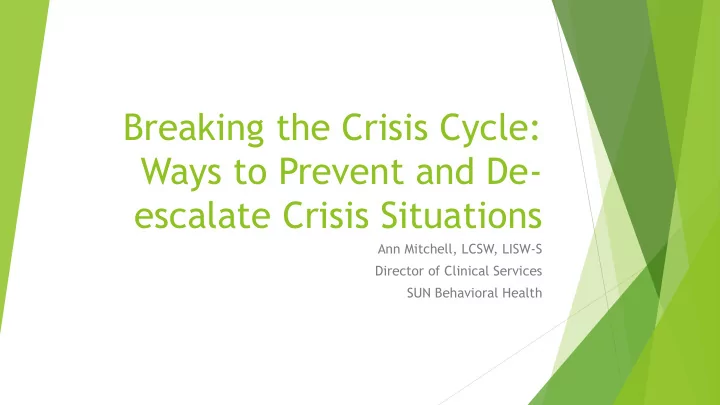

Breaking the Crisis Cycle: Ways to Prevent and De- escalate Crisis Situations Ann Mitchell, LCSW, LISW-S Director of Clinical Services SUN Behavioral Health
SUN Behavioral Health 197 bed mental health free standing hospital Assessments available 24/7 820 Dolwick Dr. Erlanger, KY 41018 859.429.5188 main 859.287.3331 direct line Populations served Mood and Anxiety Dual diagnosis Generalized psychosis Geriatrics Adolescent (12-17) Child (5-11) PHP IOP
Chinese Character For Crisis
A Crisis Occurs When A person has run out or has never developed coping skills to deal with the situation
Walkers and Standers How body Language effects effective crisis communication
Stress Model of Crisis
Effects of Anger
Four Questions We Ask Ourselves in a Crisis Situation 1. What am I feeling now? 2. What does this person feel, need, or want? 3. How is the environment affecting the person? 4. How do I best respond?
What To Do (Nonverbal Strategies) Take a deep breath Use protective stance Step back Give the situation time Sit down if appropriate Remember the importance of body language and facial expression
What To Say (Verbal Strategies) Very little Understanding responses “I can see… “ (validate feelings) “When you…” (encourage positive behaviors) “I know we…” (emphasize desirable outcomes) “I am sorry…” (offer an apology) Remember the importance of tone of voice
Meaning in Emotional Communication
I ASSIST I - Isolate the person A - Actively listen S – Speak calmly, assertively, respectfully S – Statements of understanding precede requests I – Invite the person to consider positive outcomes and behaviors S – Space reduces pressure T – Time helps people respond to requests
Recommend
More recommend